 | |
| Type | Confectionery |
|---|---|
| Place of origin | |
| Created by | Bouquet d'Or |
| Main ingredients | Marshmallow, chocolate |
Bamsemums (bearchu) is a bear shaped chocolate-covered marshmallow candy created by the chocolate factory Bouquet d'Or, in Ascq, France.
 | |
| Type | Confectionery |
|---|---|
| Place of origin | |
| Created by | Bouquet d'Or |
| Main ingredients | Marshmallow, chocolate |
Bamsemums (bearchu) is a bear shaped chocolate-covered marshmallow candy created by the chocolate factory Bouquet d'Or, in Ascq, France.
The first bear shaped chocolate-covered marshmallow candy was invented and manufactured in 1962 by the chocolate factory Bouquet d'Or, in Ascq (now Villeneuve-d'Ascq), France [1] [2] [3] under the name 'Petit ourson'.
Some confectionaries have started to make their own bear shaped chocolate-covered marshmallow candy as the Bouquet d'Or's one, as Nidar in 1975.
The Villeneuve-d'Ascq chocolate factory was bought by the Cémoi Group [4] in 2003. Since then, annual production of gummy bears has tripled, reaching 3,000 tonnes in 2012.
To celebrate the 40th anniversary of these little bears, an exclusive collector's box has been created, [5] specially designed for the Colette boutique in Paris.
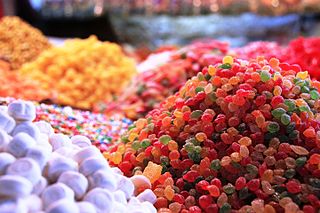
Candy, alternatively called sweets or lollies, is a confection that features sugar as a principal ingredient. The category, also called sugar confectionery, encompasses any sweet confection, including chocolate, chewing gum, and sugar candy. Vegetables, fruit, or nuts which have been glazed and coated with sugar are said to be candied.

Cap'n Crunch is a corn and oat breakfast cereal manufactured since 1963 by Quaker Oats Company, a subsidiary of PepsiCo since 2001. Since the original product introduction, marketed simply as Cap'n Crunch, Quaker Oats has since introduced numerous flavors and seasonal variations, some for a limited time—and currently offers a Cap'n Crunch product line.

A chocolate bar is a confection containing chocolate, which may also contain layerings or mixtures that include nuts, fruit, caramel, nougat, and wafers. A flat, easily breakable, chocolate bar is also called a tablet. In some varieties of English and food labeling standards, the term chocolate bar is reserved for bars of solid chocolate, with candy bar used for products with additional ingredients.
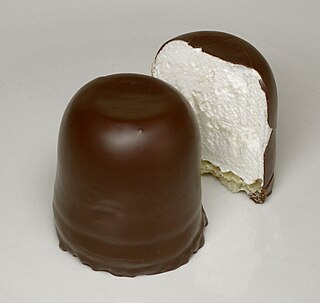
Chocolate-coated marshmallow treats, also known as chocolate teacakes, are confections consisting of a biscuit base topped with marshmallow-like filling and then coated in a hard shell of chocolate. They were invented in Denmark in the 19th century and later also produced and distributed by Viau in Montreal as early as 1901. Numerous varieties exist, with regional variations in recipes. Some variants of these confections have previously been known in many countries by names comprising equivalents of the English word negro.
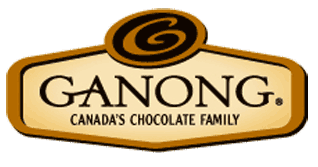
Ganong Bros., Limited is Canada's oldest candy company. It was founded by James and Gilbert Ganong in 1873 in St. Stephen, New Brunswick, where it remains. Primarily a producer of boxed chocolates and the first to introduce heart-shaped boxes, it now provides many chocolates for Laura Secord stores.

Villeneuve-d'Ascq is a commune in the Nord department in northern France. With more than 60,000 inhabitants and 50,000 students, it is one of the main cities of the Métropole Européenne de Lille and the largest in area (27.46 km2) after Lille. It is also one of the main cities of the Hauts-de-France region.
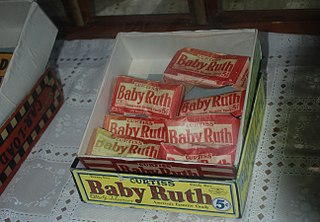
The Curtiss Candy Company is a defunct American confectionery brand and a former company based in Chicago, Illinois. It was founded in 1916 by Otto Schnering near Chicago, Illinois. Wanting a more "American-sounding" name, Schnering named his company using his mother's maiden name.

Reese's Peanut Butter Cups are an American candy by The Hershey Company consisting of a peanut butter cup encased in chocolate. They were created on November 15, 1928, by H. B. Reese, a former dairy farmer and shipping foreman for Milton S. Hershey. Reese left his job with Hershey to start his own candy business. Reese's are a top-selling candy brand worldwide, with more than $2 billion in annual sales generated for The Hershey Company.

Farley's & Sathers Candy Company was created as an umbrella company to roll up many small companies, brands and products under a common management team. The confectionery business segment is made up of many small companies, often with intertwined relationships and histories.

Boyer Candy Company is an American candy company located in Altoona, Pennsylvania. The factory is located in the downtown district. Boyer Candy is privately owned by Consolidated Brands, which is owned by the Forgione family.

Arnott's Group is an Australian producer of biscuits and snack food. Founded in 1865 by William Arnott, they are the largest producer of biscuits in Australia and a subsidiary of KKR.

Cailler is a Swiss chocolate brand and production factory based in Broc. It was founded in Vevey by François-Louis Cailler in 1819 and remained independent until the early 20th century, when it associated with other producers. Shortly before, Cailler opened its main factory at Broc in 1898. The company was finally bought by Nestlé in 1929 and became a brand. Cailler is the oldest chocolate brand still in existence in Switzerland.

E. Wedel is a Polish confectionery company, which has been producing a variety of chocolates, cakes, and snacks since 1851. Wedel is also a well-recognized brand of candy in Poland, considered to be the "Polish national chocolate brand" in that market, and is the leading candy brand among Polish producers with about 14% of the Polish market in 2005 and 11.7% in 2007.
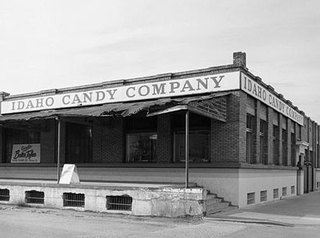
The Idaho Candy Company is a candy manufacturer in Boise, Idaho, United States. They are best known for the Idaho Spud bar, which has a cult following in the Northwestern United States. The company has been making the popular bar of marshmallow filling covered in chocolate and coconut since 1918. Though many historic candy makers have since gone out of business, in past decades, the Idaho Candy Company competed with other local producers like the Idaho Russet made by the Dainty Maid company and another "Spud Bar" from Utah made by Ostler Candy.

Gummies, gummi candies, gummy candies, or jelly sweets are a broad category of gelatin-based chewable sweets. Gummy bears, Sour Patch Kids, and Jelly Babies are widely popular and are a well-known part of the sweets industry. Gummies are available in a wide variety of shapes, most commonly seen as colorful depictions of living things such as bears, babies, or worms. Various brands such as Bassett's, Haribo, Albanese, Betty Crocker, Hersheys, Disney and Kellogg's manufacture various forms of gummy snacks, often targeted at young children. The name "gummi" originated in Germany, with the term "jelly sweets" more common in the United Kingdom.

Ascq is a former commune on the Marque river in the Nord department in northern France, at seven kilometers from Belgium. Agricultural village until the Industrial Revolution, the former independent commune merged with others to become a district of the new town planned community of Villeneuve-d'Ascq since 1970. The operatic bass Louis-Henri Obin (1820–1895) was born in Ascq.

François Asselineau is a French politician and an Inspector General for finances.

A starch mogul is a machine that makes shaped candies or candy centers from syrups or gels, such as gummi candy. These softer candies and centers are made by filling a tray with cornstarch, stamping the desired shape into the starch, and then pouring the filling or gel into the holes made by the stamp. When the candies have set, they are removed from the trays and the starch is recycled.
Cémoi is a French chocolate manufacturer founded by Jules Pares in 1814 in Arles-sur-Tech, Pyrénées-Orientales. Cémoi is the biggest French chocolate manufacturer and the 26th in the world.

Albanese Candy is a candy manufacturer in Hobart, Indiana. Founded in 1983 by Scott Albanese, it specializes in the production of gummies and chocolate-covered goods. As of 2022, the company employs roughly 700 workers and ships to 41 countries. It is said to be the home of "the world's best gummies."